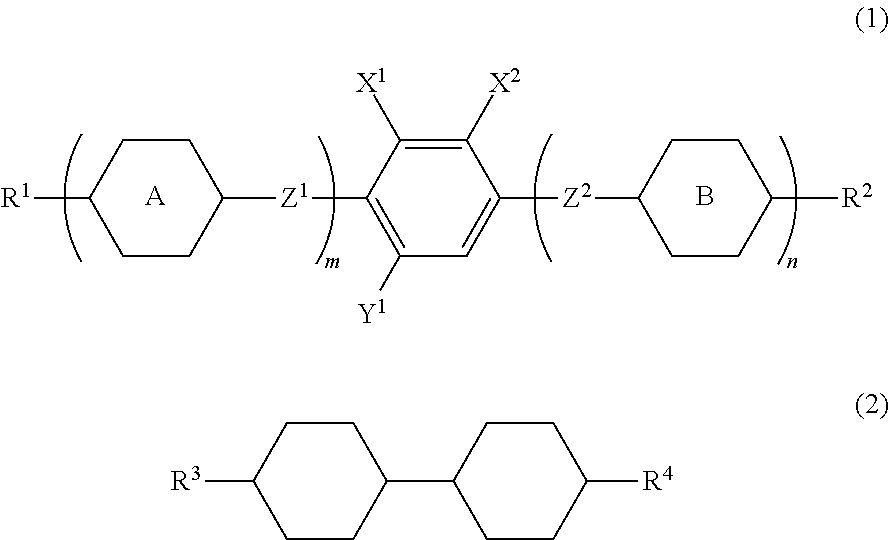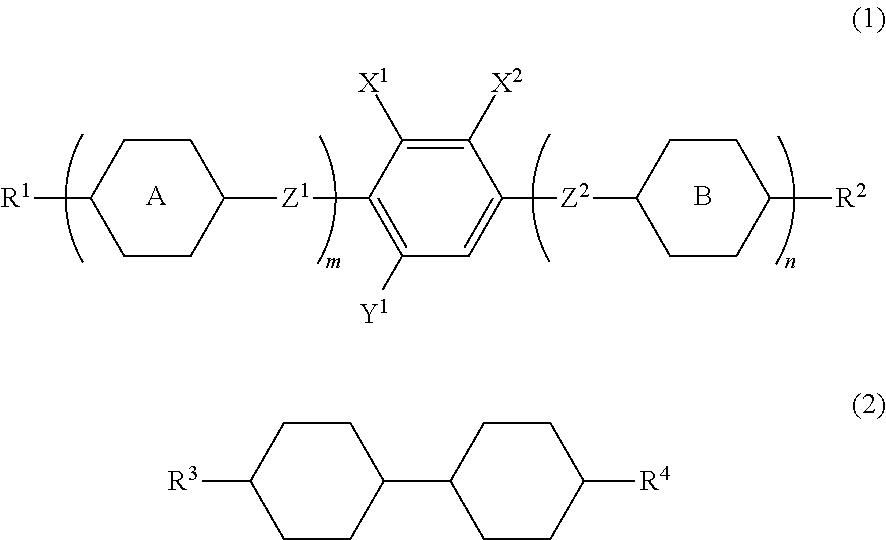Liquid crystal composition and liquid crystal display device
a liquid crystal composition and display device technology, applied in the field of liquid crystal composition and liquid crystal display device, can solve the problems of long service life of the device, and achieve the effects of small viscosity, high UV light stability, and large specific resistan
- Summary
- Abstract
- Description
- Claims
- Application Information
AI Technical Summary
Benefits of technology
Problems solved by technology
Method used
Image
Examples
example 1
[0139]Among types of compound (1-1-1), a compound as described below was manufactured.
[0140]A phase transition temperature was C 47.5 I. Moreover, the compound was mixed with mother liquid crystals, and values of characteristics of the compound were obtained according to an extrapolation method as follows: NI=−30.7° C.; Δn=0.053.
[0141]1HNMR (CDCl3) (σ): 6.83 (ddd, J=8.5, 8.2, 2.4 Hz, 1H), 6.67 (ddd, J=8.5, 8.2, 1.9 Hz, 1H), 4.53 (dt, J=47.4, 6.1, 2H), 4.09 (q, J=7.0 Hz, 2H), 2.76 (tt, J=12.2, 3.3 Hz, 1H), 1.92-1.85 (m, 4H), 1.65 (ddt, J=26.5, 6.4, 6.1 Hz, 2H), 1.57-1.42 (m, 3H), 1.43 (t, J=7.0 Hz, 3H), 1.15 (dddd, J=13.0, 12.9, 12.2, 3.3 Hz, 2H).
[0142]19FNMR (CDCl3) (σ): −143.82 (dd, J=19.7, 8.2 Hz, 1F), −160.15 (ddd, J=−19.7, 8.2, 2.4 Hz, 1F), −218.63 (tt, J=47.4, 26.5 Hz, 1F).
example 2
[0143]Among types of compound (1-1-1), a compound as described below was manufactured.
[0144]A phase transition temperature was C 58.8 I. Moreover, the compound was mixed with mother liquid crystals, and values of characteristics of the compound were obtained according to an extrapolation method as follows: NI=4.6° C.; Δ∈=−6.8; Δn=0.074.
[0145]1HNMR (CDCl3) (σ): 6.83 (ddd, J=8.4, 8.2, 2.6 Hz, 1H), 6.66 (ddd, J=8.3, 8.2, 1.9 Hz, 1H), 4.45 (dt, J=47.4, 6.3 Hz, 2H), 4.09 (q, J=7.0 Hz, 2H), 2.75 (tt, J=12.2, 3.0 Hz, 1H), 1.88-1.86 (m, 4H), 1.79-1.68 (m, 2H), 1.49-1.40 (m, 2H), 1.43 (t, J=7.0 Hz, 3H), 1.10 (dddd, J=12.7, 12.4, 12.2, 2.9 Hz, 2H).
[0146]19FNMR (CDCl3) (σ): −143.77 (dd, J=19.7, 8.4 Hz, 1F), −160.15 (ddd, J=19.7, 8.3, 2.6 Hz, 1F), −218.23 (tt, J=47.4, 12.2 Hz, 1F).
example 3
[0147]Among types of compound (1-3-1), a compound as described below was manufactured.
[0148]A phase transition temperature was C 89.8 N 183.8 I. Moreover, the compound was mixed with mother liquid crystals, and values of characteristics of the compound were obtained according to an extrapolation method as follows: NI=150.6° C.; Δ∈=−6.2; Δn=0.114; η=51.4 mPa·s.
[0149]1HNMR (CDCl3) (σ): 6.83 (ddd, J=8.2, 7.7, 2.2 Hz, 1H), 6.66 (ddd, J=8.2, 8.1, 1.9 Hz, 1H), 4.43 (dt, J=47.5, 6.3 Hz, 2H), 2.72 (tt, J=12.2, 3.1 Hz, 1H), 1.88-1.65 (m, 10H), 1.44-1.37 (m, 2H), 1.43 (t, J=7.0, 3H), 1.30-1.25 (m, 2H), 1.20-0.86 (m, 9H).
[0150]19FNMR (CDCl3) (a): −143.83 (dd, J=19.7, 7.7 Hz, 1F), −160.21 (ddd, J=19.7, 8.1, 2.2 Hz, 1F), −218.06 (tt, J=47.5, 24.4 Hz, 1F).
PUM
| Property | Measurement | Unit |
|---|---|---|
| Temperature | aaaaa | aaaaa |
| Temperature | aaaaa | aaaaa |
| Nanoscale particle size | aaaaa | aaaaa |
Abstract
Description
Claims
Application Information
 Login to View More
Login to View More - R&D
- Intellectual Property
- Life Sciences
- Materials
- Tech Scout
- Unparalleled Data Quality
- Higher Quality Content
- 60% Fewer Hallucinations
Browse by: Latest US Patents, China's latest patents, Technical Efficacy Thesaurus, Application Domain, Technology Topic, Popular Technical Reports.
© 2025 PatSnap. All rights reserved.Legal|Privacy policy|Modern Slavery Act Transparency Statement|Sitemap|About US| Contact US: help@patsnap.com



